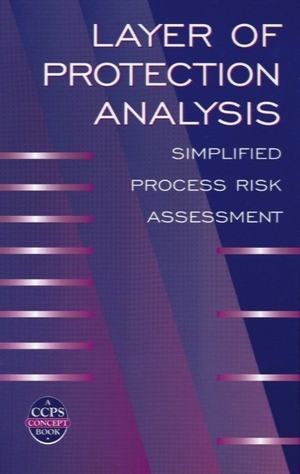Layer of protection analysis : simplified process risk assessment
- نوع فایل : کتاب
- زبان : انگلیسی
- مؤلف : Daniel A Crowl; Arthur M Dowell
- ناشر : New York : CCPS
- چاپ و سال / کشور: 2001
- شابک / ISBN : 9780816908110
Description
Preface xi Acknowledgments xiii Acronyms and Abbreviations xvi 1 Introduction 1.1. Audience 1 1.2. History of LOPA 2 1.3. Use of LOPA in the Process Life Cycle 5 1.4. Linkage to Other CCPS Publications 7 1.5. Annotated Outline of the LOPA book 8 2 Overview of LOPA 2.1. Purpose 11 2.2. What Is LOPA? 11 2.3. What LOPA Does 12 2.4. When to Use LOPA 142.5. How LOPA Works 16 2.6. How to Implement LOPA 24 2.7. Limitations of LOPA 24 2.8. Benefits of LOPA 26 2.9. Introduction of Continuing Examples 27 3 Estimating Consequences and Severity 3.1. Purpose 31 3.2. Consequences of Interest 31 3.3. Consequence Evaluation Approaches for LOPA 33 3.4. Continuing Examples 40 3.5. Link Forward 42 4 Developing Scenarios 4.1. Purpose 43 4.2. LOPA Scenarios and Components 43 4.3. Identifying and Developing Candidate Scenarios 47 4.4. Continuing Examples 52 4.5. Link Forward 61 5 Identifying Initiating Event Frequency 5.1. Purpose 63 5.2. Initiating Events 63 5.3. Frequency Estimation 68 5.4. Expression of Failure Rates 73 5.5. Continuing Examples 73 5.6. Limitations (Cautions) 74 5.7. Link Forward 74Identifying Independent Protection Layers 6.1. Purpose 75 6.2. Definition and Purpose of an IPL 75 6.3. IPL Rules 80 6.4. LOPA IPL Assessment 88 6.5. Examples of IPLs 90 6.6. Preventive IPLs versus Mitigation IPLs 104 6.7. Continuing Examples 106 6.8. Link Forward 113 7 Determining the Frequency of Scenarios 7.1. Purpose 115 7.2. Quantitative Calculation of Risk and Frequency 115 7.3. Look-up Table Determination of Risk or Frequency 122 7.4. Calculation of Risk or Frequency with Integer Logarithms 124 7.5. Continuing Examples 125 7.6. Link Forward 130 8 Using LOPA to Make Risk Decisions 8.1. Purpose 131 8.2. Introduction 131 8.3. Comparing Calculated Risk to Scenario Risk Tolerance Criteria 133 8.4. Expert Judgment 137 8.5. Using Cost–Benefit to Compare Alternatives 137 8.6. Comparison of Approaches, Pros and Cons 137 8.7. Cumulative Risk Criteria versus Scenario Criteria 139 8.8. Continuing Examples 140 8.9. Cautions 148 8.10. Link Forward 149Implementing LOPA 9.1. Purpose 151 9.2. Is the Company Ready for LOPA? 151 9.3. What Is the Current Foundation for Risk Assessment? 152 9.4. What Data Are Required? 153 9.5. Will the IPLs Remain in Place? 155 9.6. How Are the Risk Tolerance Criteria Established? 156 9.7. When Is LOPA Used? 158 9.8. Typical Implementation Tasks 158 10 Using LOPA for Other Applications 10.1. Purpose 163 10.2. Using LOPA in Capital Improvement Planning 164 10.3. Using LOPA in Management of Change 165 10.4. Using LOPA in Mechanical Integrity Programs or Risk-Based Inspection/Risk-Based Maintenance Programs 166 10.5. Using LOPA in Risk-Based Operator Training 166 10.6. Using LOPA in Emergency Response Planning 167 10.7. Using LOPA to Determine a Credible Design Basis for Overpressure Protection 167 10.8. Using LOPA in Evaluating Facility Siting Risks 169 10.9. Using LOPA to Evaluate the Need for Emergency Isolation Valves 170 10.10. Using LOPA to Evaluate Taking a Safety System Out of Service 171 10.11. Using LOPA during Incident Investigations 172 10.12. Using LOPA in the Determination of SIL for SIF 172 11 Advanced LOPA Topics 11.1. Purpose 173 11.2. Counting Multiple Functions in One BPCS as IPLs in the Same Scenario11.3. Summation of Risk for Multiple Scenarios 184 11.4. Using LOPA to Develop F/N Curves 186 11.5. Operator Response Issues 188 11.6. Normal Plant Operations as “Tests” of IPL Components 189 11.7. Focused Fault Tree/Event Tree Analysis of IPL Components 189 APPENDIX A: LOPA Summary Sheets for the Continuing Examples 191 APPENDIX B: Worked Examples from CCPS’s Safe Automation Book 211 APPENDIX C: Documentation for a LOPA Study 231 APPENDIX D: Linkage with Other Publications 237 APPENDIX E: Industry Risk Tolerance Criteria Data 243 APPENDIX F: High Initiating Event Frequency Scenarios 247 APPENDIX G: Additional Reading 251 References 255 Glossary of Terms 259 Index 265


